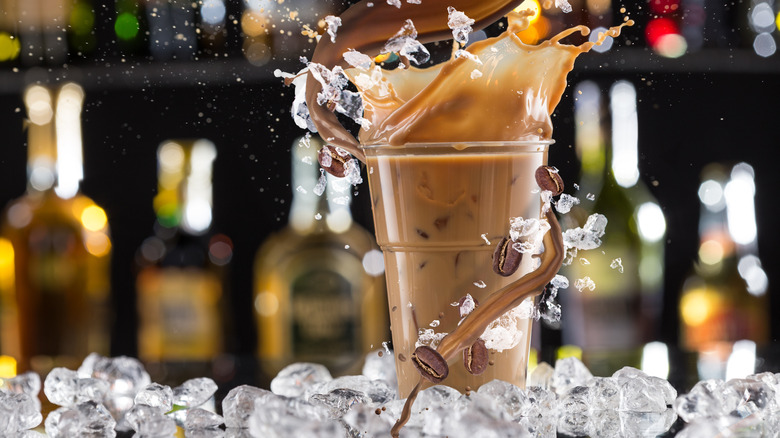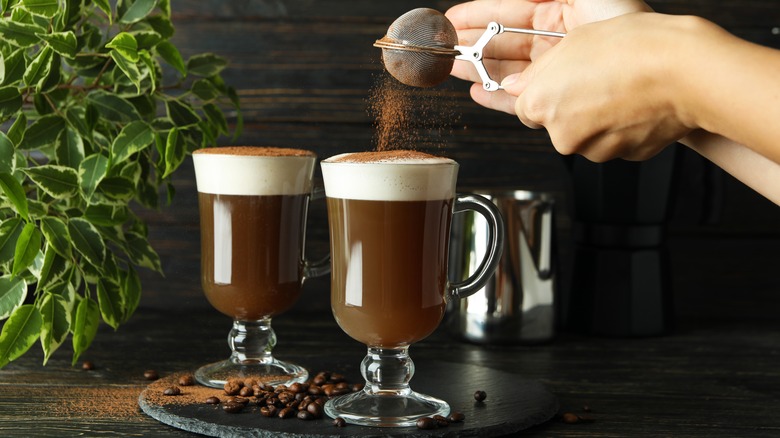Espresso Martini Vs. Irish Coffee: What's The Difference?
Coffee cocktails are nothing new – but good ones are sometimes hard to find. That's especially true when it comes to Irish coffee drinks, which tend to draw a passionate pub crowd when the topic arises. Another relative newcomer to the scene, the espresso martini, has solid aficionados as well. Its creation story even infuses a pop-culture element into the conversation, with its supposed origins tied to a still-unrevealed fashion model, according to Ketel One.
But in everyday life, the real intrigue arises from what's in the cup — how it tastes, the cleverly crafted ingredients, and how especially delightful it feels traveling down your throat to warm your belly. That's why it's important to brush up on your coffee cocktail options, starting with the difference between an Irish coffee and an espresso martini.
The first and obvious distinction is that one lands cold in your cup, while the other steams its way into your evening.
What is an Irish coffee?
With Irish coffee, it's all about hot coffee, sugar, booze, and cream. How you work with those four elements dictates whether your cup ultimately holds some Irish magic or a cheap imitation. As The Guardian points out, this namesake Irish cocktail nosedives when choosing low-quality coffee, adding cheap whiskey, or topping if off with spray whipped cream.
A true Irish coffee strives to at least resemble the original version, created by chef Joe Sheridan in an airport café, according to Foynes Flying Boat & Maritime Museum. On a wintry night in 1942, a flight that left from the Foynes terminal near Limerick, Ireland experienced inclement weather, forcing a return to the airport. The weary passengers luckily became part of cocktail history as the chef soothed customer spirits with a shot of Irish whiskey in their coffee.
When making an Irish coffee today, remember to keep it simple. There's still, however, an art to getting it right. The original Foynes Irish coffee recipe recommends pre-heating the cup with boiling water, then pouring it out just before adding a teaspoon of brown sugar and a "good measure" of true Irish whiskey (how much is clearly open to interpretation.) Add brewed coffee up to about one-half inch of the rim, then dribble lightly whipped real cream over a spoon into the cup — no mixing. The Guardian cautions not to skip the sugar, because the cream won't float properly without it.
What is an espresso martini?
The espresso martini cocktail is a brainchild of the 1980s according to Liquor.com, which credits a London bar and a British drink-meister. Legend has it that bartender Dick Bradsell created the classy cold drink at Fred's Club to satisfy the thirsty yearnings of a famous fashion model. Though variations exist, the original concoction cradled a crafty mix of espresso, coffee liqueur, and vodka.
Liquor.com's tried-and-true version of the espresso cocktail uses the shaken-not-stirred approach. Unlike an Irish coffee, this recipe is pretty straightforward. Simply add about two ounces of vodka into a cocktail shaker, followed by a half-ounce of Kahlúa or similar coffee liqueur, an ounce of cooled-down espresso or cold-brew concentrate, a half-ounce of simple syrup, and some ice cubes. Shake it all up, pour into a chilled glass, and drop in a few whole coffee beans to garnish.
Tito's Vodka mentions adding an optional half-ounce of creamer into the mix before shaking. However, it's not necessary, even if you want a frothy foam at the top. According to Absolut Drinks, you can achieve that by proper shaking. "Remember to wake the drink to life, do not rock it to bed," they advise. Then strain it quickly from the shaker to plant the fresh, fluffy foam atop your masterpiece.


